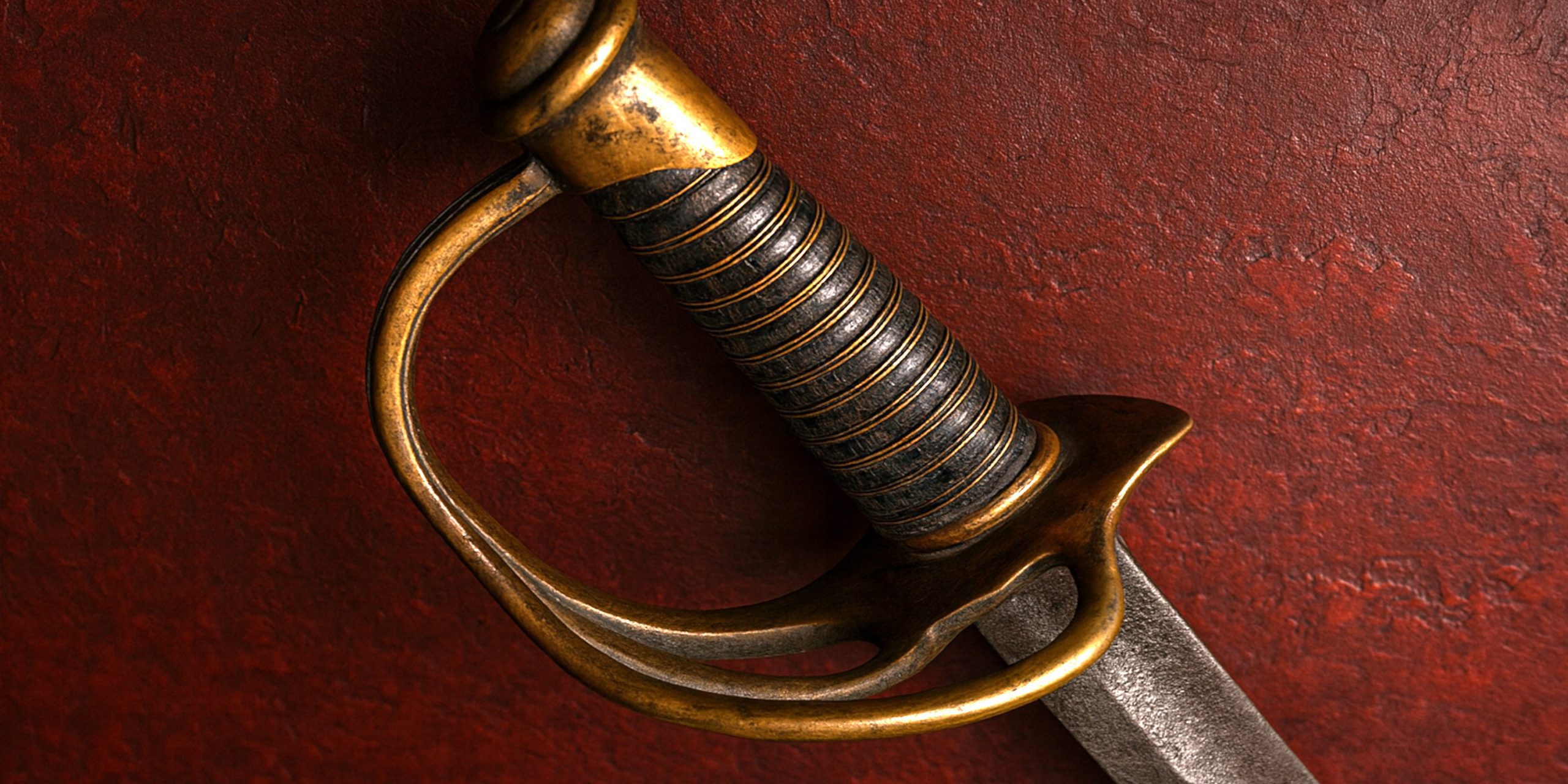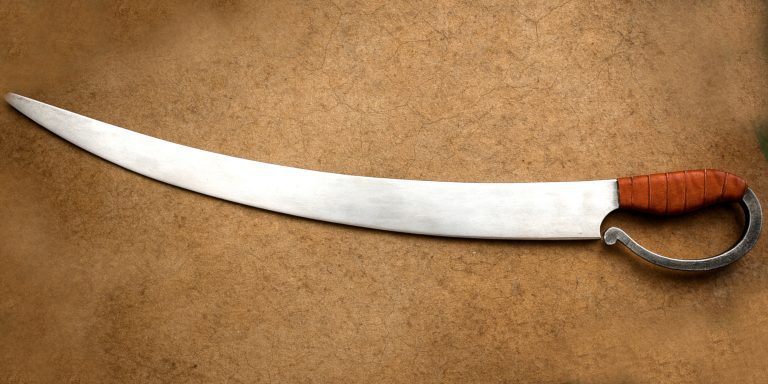
The Dog River Confederate sabre is a product of necessity, resourcefulness, and southern craftsmanship during the American Civil War. Produced in the Confederate States, primarily in Alabama, this sabre was a local imitation of the U.S. Model 1840 Cavalry Sabre, nicknamed the “Wrist Breaker”. It was forged by small workshops and armouries around the South, collectively referred to as “Dog River” after an early and somewhat mysterious manufacturing site near Mobile, Alabama.
While never as refined as its Northern counterparts, the Dog River sabre became a symbol of Confederate resilience and ingenuity in the face of industrial disadvantage.
Specification
| Aspect | Detail |
|---|---|
| Origin | Confederate States, circa 1861–1865 |
| Primary Makers | Dog River Works (Mobile, Alabama) and various independent Southern contractors |
| Blade Type | Curved single-edged cavalry sabre |
| Length | Approximately 40 inches (102 cm) overall |
| Blade Length | Around 35 inches (89 cm) |
| Weight | Roughly 2.5 lbs (1.1 kg) |
| Guard | Brass three-branch hilt or simplified iron guard |
| Grip | Wood core with leather wrap and twisted brass wire (often crudely finished) |
| Scabbard | Iron or tin-plated steel, frequently hand-forged and unpolished |
| Markings | Usually unmarked, sometimes crudely stamped “CSA” or left blank |
History and Evolution
- Civil War Context: When the Civil War began in 1861, the South faced an acute shortage of arms and equipment. With limited access to Northern manufacturing and European imports, local blacksmiths and small foundries began producing sabres to equip Confederate cavalry.
- Dog River Works: The name “Dog River” comes from a waterway near Mobile, Alabama, where one of the first Confederate sword-making operations was reportedly located. However, “Dog River” became a generic term for any Confederate-made sabre lacking a formal manufacturer’s mark.
- Design Influence: The sabre closely followed the U.S. Model 1840 design but was simplified due to limited materials and tools. Many examples exhibit asymmetrical hilts, imperfect curvature, and uneven tempering.
- Wartime Distribution: Issued to Confederate cavalry units such as the Alabama and Georgia regiments, the Dog River sabre served as both a weapon and a badge of honour, despite its practical shortcomings.
Advantages and Disadvantages
| Advantages | Disadvantages |
|---|---|
| Locally produced and readily available to Confederate cavalry. | Crude forging and inconsistent steel quality. |
| Simple, functional design based on a proven model. | Poor tempering led to brittle or soft blades. |
| Lightweight and easy to handle for mounted troops. | Many examples were unbalanced and lacked professional finish. |
| Symbol of Confederate independence and self-sufficiency. | Inferior to Union-made Ames or European sabres in performance. |
Comparison with Similar Weapons
| Weapon | Origin | Comparison |
|---|---|---|
| U.S. Model 1840 Cavalry Sabre | United States | The Dog River was a direct copy but of lower quality; the Union blade was factory-tempered and better balanced. |
| U.S. Model 1860 Light Cavalry Sabre | United States | Lighter and more refined; the 1860 was easier to wield and less fatiguing in prolonged combat. |
| French Model 1822 Sabre | France | The inspiration for both U.S. designs; superior metallurgy and craftsmanship compared to Dog River sabres. |
| Confederate Kenansville Sabre | North Carolina, CSA | A higher-quality Southern alternative with better finishing and balance. |
Legacy
The Dog River Confederate sabre has become an enduring symbol of the Confederacy’s resourcefulness and limitations. Collectors and historians view it as a tangible reminder of the South’s struggle to sustain its forces under material scarcity. Each surviving sabre varies in construction, offering insight into the region’s decentralised wartime industry.
While rarely a masterpiece of metallurgy, the Dog River sabre remains a coveted relic among Civil War collectors for its historical authenticity and connection to individual craftsmanship.
Where to See
- Museum of the Confederacy (Richmond, Virginia) – Holds several Dog River sabres, including unmarked and field-modified examples.
- American Civil War Museum (Appomattox, Virginia) – Displays Confederate cavalry weapons and locally forged sabres.
- Atlanta History Center (Georgia) – Includes Confederate arms exhibits featuring Dog River-type sabres.
- Private Collections – Numerous examples remain in private hands, often displayed at Civil War fairs and reenactments.
Collectors Guide
Desirability Factors
- Unmarked, authentic Confederate manufacture.
- Original grip, wire, and scabbard.
- Provenance to a specific Confederate regiment.
- Minimal restoration or cleaning.
Common Issues
- Rusted or pitted blades due to inferior steel.
- Cracked grips and missing wire wrap.
- Misidentified reproductions (beware modern fakes).
Auction Prices (Approximate Range)
| Condition | Estimated Price (GBP) | Notes |
|---|---|---|
| Excellent, with scabbard and provenance | £3,500–£6,000 | Museum or high-end collector grade. |
| Good, complete but worn | £1,800–£3,000 | Most common among private sales. |
| Fair, partial restoration or missing scabbard | £1,000–£1,500 | Display quality but not investment-grade. |
| Poor, damaged or unverified | £400–£900 | Often confused with replicas or later copies. |
Conclusion
The Dog River Confederate sabre is a weapon that tells a broader story about industrial improvisation and regional identity in wartime America. Crude yet charismatic, it reflects the determination of the Confederate soldier to ride into battle armed with what his own people could forge. Though overshadowed by its Union equivalents, it remains one of the most evocative artefacts of Civil War material culture.



